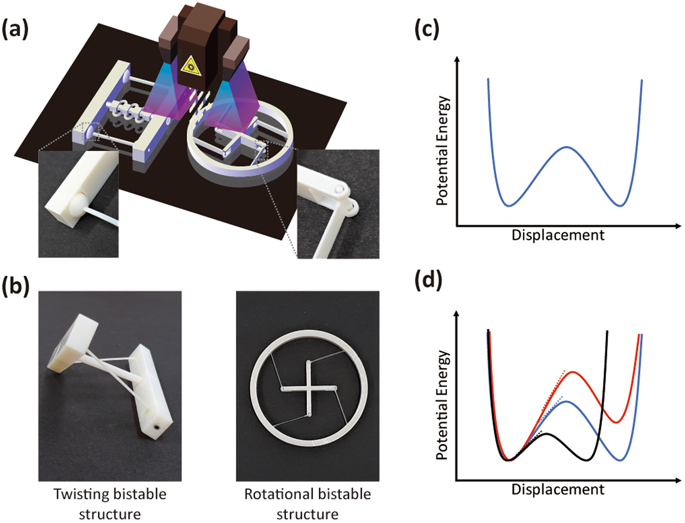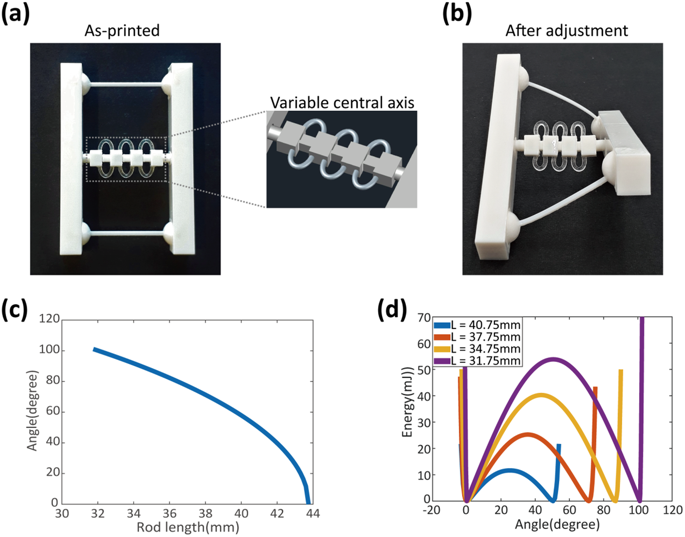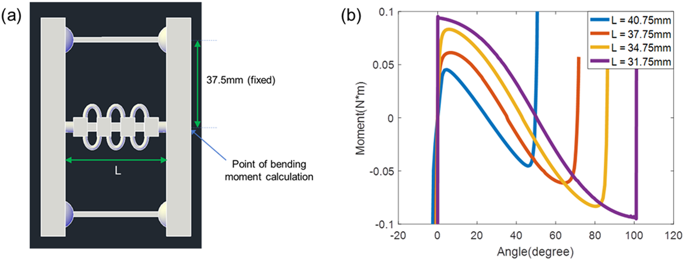In a paper entitled “3D printing of twisting and rotational bistable structures with tuning elements,” a group of researchers points out that most 3D printed structures so far have been “static structures with fixed shapes and functions.” They then go on to introduce bistability to 3D printing – particularly twisting and rotational bistable structures. They use shape memory polymers (SMPs) to do so; SMPs are smart materials that can memorize a permanent shape as well as have multiple temporary shapes.
“We first present 3D-printed bistable structures that allow twisting and rotational reconfiguration,” the researchers state. “Our designs are based on compliant mechanisms but, unlike conventional monolithic structures without joints, we introduce special joints that allow 3D printing of whole components without post-assembly. These joints are also important for the tuning of bistability. Then, by employing SMP elements, we demonstrate tunable bistable components.”
Using tunable SMP elements embedded in twisting and rotational components, the researchers were able to adjust twisting or rotational angles and control the overall shape of the bistability-energy diagram. These tunable bistable components can be used for simplified motion control in actuators or for mechanical switches.
A Stratasys J750 multi-material 3D printer was used to 3D print the components. The researchers introduced special joints to construct twisting and rotational bistable components without post-assembly. Ball joints were used in twisting components, and pin joints in rotational ones.
“Moreover, by introducing SMPs, we demonstrated tunable bistability in both twisting and rotational components,” they continue. “By designing proper SMP elements, we could readjust the bistability-energy diagram after printing and achieve tunable bistable structures. This significantly increases the tunability and applicability of bistability in various 3D-printed components.”
Bistable structures have two stable states that are separated by an energy barrier.
“These stable states are the local minima of the elastic-potential-energy diagram,” the researchers explain. “Switching between two stable configurations (states A and B) can be done reversibly many times through proper mechanical actions with lateral or rotational forces. The slope in the potential-energy diagram indicates the force applied at a given displacement. To overcome the energy barrier and induce transformation into the other shape, we should apply enough energy to overcome this barrier. Once we pass the hill of the barrier, the structure will be deformed into another stable, lower-energy state automatically without additional energy.”
A bistable structure remains stable over time without energy consumption because it is in a stable-energy position. Small disturbances do not change the stable position, the researchers continue, so an open-loop motion control system is adequate for accurate motion control.
Introducing SMPs into bistable components can potentially enable stimuli-responsive motions that are useful for smart and programmable sensors and actuators, according to the researchers. SMPs can be used to enable active reconfiguration in bistable structures.
Authors of the paper include Hoon Yeub Jeung, Soo-Chan An, In Cheol Seo, Eunseo Lee, Sangho Ha, Namhun Kim and Young Chul Jun.
Discuss this and other 3D printing topics at 3DPrintBoard.com or share your thoughts below.
Subscribe to Our Email Newsletter
Stay up-to-date on all the latest news from the 3D printing industry and receive information and offers from third party vendors.
Print Services
Upload your 3D Models and get them printed quickly and efficiently.
You May Also Like
Reinventing Reindustrialization: Why NAVWAR Project Manager Spencer Koroly Invented a Made-in-America 3D Printer
It has become virtually impossible to regularly follow additive manufacturing (AM) industry news and not stumble across the term “defense industrial base” (DIB), a concept encompassing all the many diverse...
Inside The Barnes Global Advisors’ Vision for a Stronger AM Ecosystem
As additive manufacturing (AM) continues to revolutionize the industrial landscape, Pittsburgh-based consultancy The Barnes Global Advisors (TBGA) is helping shape what that future looks like. As the largest independent AM...
Ruggedized: How USMC Innovation Officer Matt Pine Navigates 3D Printing in the Military
Disclaimer: Matt Pine’s views are not the views of the Department of Defense nor the U.S. Marine Corps Throughout this decade thus far, the military’s adoption of additive manufacturing (AM)...
U.S. Congress Calls Out 3D Printing in Proposal for Commercial Reserve Manufacturing Network
Last week, the U.S. House of Representatives’ Appropriations Committee moved the FY 2026 defense bill forward to the House floor. Included in the legislation is a $131 million proposal for...




































